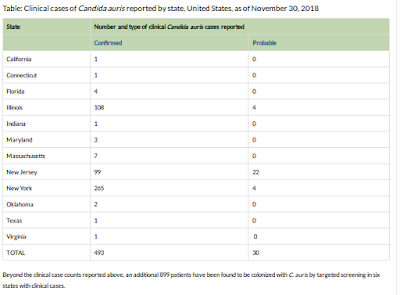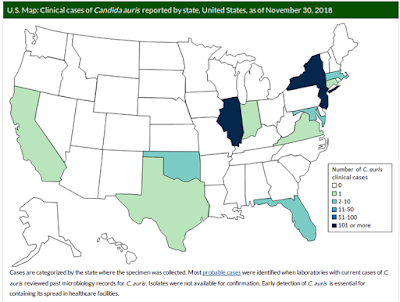 |
| Credit CDC |
#13,754
In June of 2016 the CDC issued a Clinical Alert to U.S. Health care facilities about the Global Emergence of Invasive Infections Caused by the Multidrug-Resistant Yeast Candida auris.
C. auris is an emerging fungal pathogen that was first isolated in Japan in 2009. It was initially found in the discharge from a patient's external ear (hence the name `auris'). Retrospective analysis has traced this fungal infection back over 20 years.Since then the CDC and public health entities have been monitoring an increasing number of cases (and hospital clusters) in the United States and abroad, generally involving bloodstream infections, wound infections or otitis.
Adding to the concern:
- C. auris infections have a high fatality rate
- The strain appears to be resistant to multiple classes of anti-fungals
- This strain is unusually persistent on fomites in healthcare environments.
- And it can be difficult for labs to differentiate it from other Candida strains
New York, New Jersey, and Illinois continue to lead the pack, making up 95% (n=472) of the 493 confirmed cases. Additionally, 899 patients have been found to be colonized with C. auris by targeted screening conducted in six states with clinical cases.
Tracking Candida auris
December 21, 2018: Case Count Updated as of November 30, 2018
Candida auris is an emerging fungus that presents a serious global health threat. C. auris causes severe illness in hospitalized patients in several countries, including the United States. Patients can remain colonized with C. auris for a long time and C. auris can persist on surfaces in healthcare environments. This can result in spread of C. auris between patients in healthcare facilities.
Most C. auris cases in the United States have been detected in the New York City area, New Jersey, and the Chicago area. Strains of C. auris in the United States have been linked to other parts of the world. U.S. C. auris cases are a result of inadvertent introduction into the United States from a patient who recently received healthcare in a country where C. auris has been reported or a result of local spread after such an introduction.
Candida auris was made nationally notifiable at the 2018 Council for State and Territorial Epidemiologists (CSTE) Annual Conference. For the updated case definition and information on the nationally notifiable condition status, which will go into effect in 2019, please see the 2018 CSTE position statement[PDF – 16 pages].
As depicted the the following CDC map, C. auris is very much a global problem, although limited surveillance prevents us from knowing just how widespread this fungal infection really is.
For more information visit the CDC's Information for Laboratorians and Health Professionals page, including:
Resources
Information for Laboratorians and Infection Preventionists
Patient Education
- Information for Infection Preventionists – Print only version[PDF – 2 pages]
- Information for Laboratory Staff – Print only version[PDF – 2 pages]


